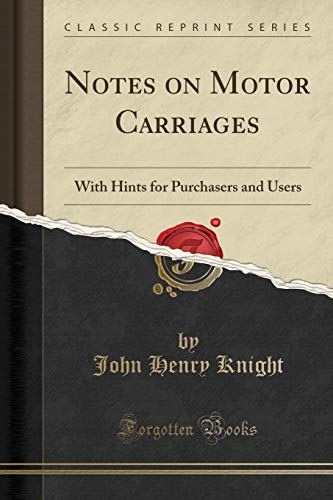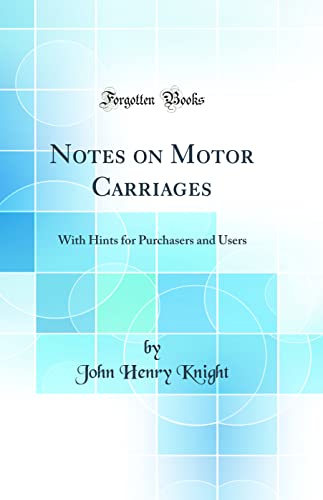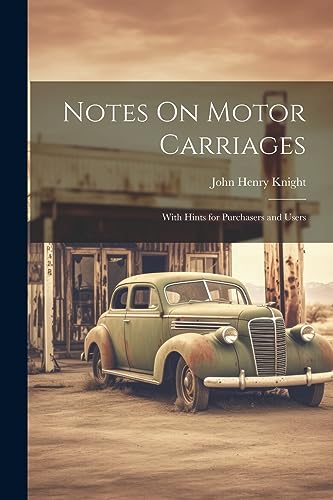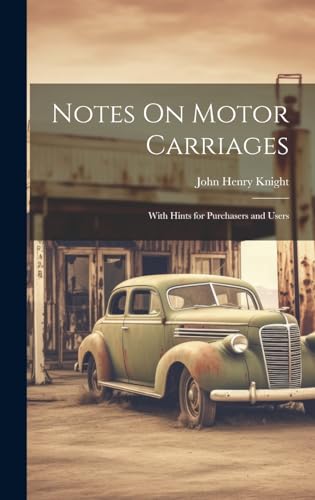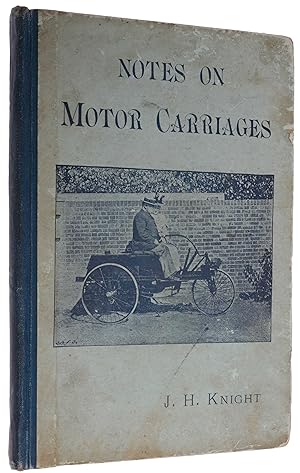notes motor carriages hints purchasers von john henry knight (11 Ergebnisse)
FeedbackSuchfilter
Produktart
- Alle Product Types
- Bücher (11)
- Magazine & Zeitschriften (Keine weiteren Ergebnisse entsprechen dieser Verfeinerung)
- Comics (Keine weiteren Ergebnisse entsprechen dieser Verfeinerung)
- Noten (Keine weiteren Ergebnisse entsprechen dieser Verfeinerung)
- Kunst, Grafik & Poster (Keine weiteren Ergebnisse entsprechen dieser Verfeinerung)
- Fotografien (Keine weiteren Ergebnisse entsprechen dieser Verfeinerung)
- Karten (Keine weiteren Ergebnisse entsprechen dieser Verfeinerung)
- Manuskripte & Papierantiquitäten (Keine weiteren Ergebnisse entsprechen dieser Verfeinerung)
Zustand Mehr dazu
- Neu (8)
- Wie Neu, Sehr Gut oder Gut Bis Sehr Gut (Keine weiteren Ergebnisse entsprechen dieser Verfeinerung)
- Gut oder Befriedigend (1)
- Ausreichend oder Schlecht (Keine weiteren Ergebnisse entsprechen dieser Verfeinerung)
- Wie beschrieben (2)
Einband
Weitere Eigenschaften
- Erstausgabe (1)
- Signiert (Keine weiteren Ergebnisse entsprechen dieser Verfeinerung)
- Schutzumschlag (Keine weiteren Ergebnisse entsprechen dieser Verfeinerung)
- Angebotsfoto (4)
Sprache (2)
Gratisversand
Land des Verkäufers
Verkäuferbewertung
-
Notes on Motor Carriages: With Hints for Purchasers and Users (Classic Reprint)
Anbieter: PBShop.store US, Wood Dale, IL, USA
EUR 19,96
Währung umrechnenKostenlos für den Versand innerhalb von/der USAAnzahl: 15 verfügbar
In den WarenkorbPAP. Zustand: New. New Book. Shipped from UK. Established seller since 2000.
-
Notes on Motor Carriages: With Hints for Purchasers and Users (Classic Reprint)
Anbieter: PBShop.store UK, Fairford, GLOS, Vereinigtes Königreich
EUR 18,30
Währung umrechnenEUR 3,78 für den Versand von Vereinigtes Königreich nach USAAnzahl: 15 verfügbar
In den WarenkorbPAP. Zustand: New. New Book. Shipped from UK. Established seller since 2000.
-
Notes on Motor Carriages With Hints for Purchasers and Users Classic Reprint
Anbieter: PBShop.store US, Wood Dale, IL, USA
EUR 25,52
Währung umrechnenKostenlos für den Versand innerhalb von/der USAAnzahl: 15 verfügbar
In den WarenkorbHRD. Zustand: New. New Book. Shipped from UK. Established seller since 2000.
-
Notes on Motor Carriages With Hints for Purchasers and Users Classic Reprint
Anbieter: PBShop.store UK, Fairford, GLOS, Vereinigtes Königreich
EUR 22,95
Währung umrechnenEUR 4,78 für den Versand von Vereinigtes Königreich nach USAAnzahl: 15 verfügbar
In den WarenkorbHRD. Zustand: New. New Book. Shipped from UK. Established seller since 2000.
-
Notes On Motor Carriages: With Hints for Purchasers and Users
Anbieter: Ria Christie Collections, Uxbridge, Vereinigtes Königreich
EUR 14,75
Währung umrechnenEUR 13,76 für den Versand von Vereinigtes Königreich nach USAAnzahl: Mehr als 20 verfügbar
In den WarenkorbZustand: New. In.
-
Notes On Motor Carriages: With Hints for Purchasers and Users
Anbieter: Ria Christie Collections, Uxbridge, Vereinigtes Königreich
EUR 29,49
Währung umrechnenEUR 13,76 für den Versand von Vereinigtes Königreich nach USAAnzahl: Mehr als 20 verfügbar
In den WarenkorbZustand: New. In.
-
Notes On Motor Carriages: With Hints for Purchasers and Users
Verlag: Creative Media Partners, LLC Jul 2023, 2023
ISBN 10: 1021923435 ISBN 13: 9781021923431
Sprache: Englisch
Anbieter: AHA-BUCH GmbH, Einbeck, Deutschland
EUR 25,50
Währung umrechnenEUR 60,32 für den Versand von Deutschland nach USAAnzahl: 2 verfügbar
In den WarenkorbTaschenbuch. Zustand: Neu. Neuware.
-
Notes On Motor Carriages: With Hints for Purchasers and Users
Verlag: Creative Media Partners, LLC Aug 2024, 2024
ISBN 10: 1020024127 ISBN 13: 9781020024122
Sprache: Englisch
Anbieter: AHA-BUCH GmbH, Einbeck, Deutschland
EUR 41,49
Währung umrechnenEUR 61,16 für den Versand von Deutschland nach USAAnzahl: 2 verfügbar
In den WarenkorbBuch. Zustand: Neu. Neuware - In this charming and informative book, John Henry Knight offers practical advice and insights for anyone considering purchasing or using a motor carriage. With a wealth of tips and hints for navigating the early days of automobiles, the book is a delightful window into a bygone era.
-
Notes on Motor Carriages : With Hints for Purchasers and Users (Classic Reprint)
Anbieter: Buchpark, Trebbin, Deutschland
EUR 19,22
Währung umrechnenEUR 105,00 für den Versand von Deutschland nach USAAnzahl: 1 verfügbar
In den WarenkorbZustand: Hervorragend. Zustand: Hervorragend | Sprache: Englisch | Produktart: Bücher.
-
Notes on Motor Carriages with Hints for Purchasers and Users.
Verlag: Hazell, Watson & Viney, London 1896, 1896
Anbieter: ROBIN SUMMERS BOOKS LTD, Aldeburgh, Vereinigtes Königreich
Erstausgabe
EUR 828,26
Währung umrechnenEUR 28,72 für den Versand von Vereinigtes Königreich nach USAAnzahl: 1 verfügbar
In den WarenkorbZustand: Very Good. First edition. Hardback. Octavo. 84pp. Original quarter blue cloth over pale blue illustrated paper covered boards. Slight rubbing, fading and marks to covers, spine ends lightly rubbed, otherwise very good. No jacket.
-
Notes on Motor Carriages with Hints for Purchasers and Users
Verlag: Hazell, Watson and Viney, London, 1896
Anbieter: SOPHIA RARE BOOKS, Koebenhavn V, Dänemark
EUR 3.072,41
Währung umrechnenKostenlos für den Versand von Dänemark nach USAAnzahl: 1 verfügbar
In den WarenkorbINSCRIBED PRESENTATION COPY DIBNER 184. First edition, inscribed presentation copy, of this scarce early study on automobiles by the inventor and engineer John Henry Knight. "The development of the automobile is of great historic importance in the history of technology. Of all the early works written on the subject, this book by Knight had a great impact on both the makers and the users of automobiles" (Dibner online). "There were many who attempted to apply the power of small gasoline, gas-generator or electric battery propulsion to a carriage and to make an automobile. The release of the Otto 4-cycle engine patent from monopoly control in 1885 multiplied these efforts and many 'horseless carriages' took to the roads of America and Europe. Prominent names among the more successful pioneers in this effort are Daimler, Benz, Peugeot, Duryea and Mueller. It was in the methods of automobile manufacture and the approach to the mass market that the 20th century inventors and industrialists developed new sociological concepts of great and lasting importance" (Dibner, 25th Anniversary Edition). This book was written soon after Knight's construction of one of Britain's first petrol-powered motor vehicles. The book includes chapters on several famous makes of cars, including Benz, Decauville, Motor Mfg. Co., New Orleans, Argyll & De Dion Voiturette, Serpollet, and Stanley Steam Car. There are also discussions on motor bicycles and tricycles such as Singer, Minerva, etc. The author counselled prospective buyers "to see the machine taken to pieces and put together again before purchasing." Knight also documented some of the earliest motor-sport events, including the 1894 Paris-Rouen and 1895 Paris-Bordeaux-Paris races. "John Henry Knight (1847-1917), from Farnham, Surrey, UK, was a wealthy engineer, landowner and inventor. With the help of the engineer George Parfitt he built one of Britain's first petrol-powered motor vehicles On 17 October 1895, with his assistant James Pullinger, they drove through Farnham, Surrey, whereupon he was prosecuted for using a locomotive with neither a licence nor a man walking in front with a red flag Knight was a founder member of the Automobile Association and politically active in the repeal of the Red Flag Act" (Wikipedia). ABPC/RBH list four copies in the last 45 years, but no presentation copies. Provenance: F. Crowley (?) (author's presentation inscription on title). "John Henry Knight was born in 1847 to John Knight, a banker and brewer of Farnham, who died in 1856 when John Henry was 9 years old. His mother was Mary Knight. His father's will bequeathed him title to, among other things, 'The Anchor Inn, Normandy' when he was 21 years old. He was born and raised at Weybourne House, Weybourne, Farnham, Surrey, which still stands today. He then moved to Barfield in Runfold, just outside Farnham, which is now a Preparatory school (whose alumni include Mike Hawthorn). "He was inspired by The Great Exhibition of 1851 and went on to train as an engineer, developing an early enthusiasm for steam powered road-going transport. He owned an engineering works on West Street, Farnham. "In 1895 Knight built one of Britain's first petrol-powered motor vehicles, a three-wheeled, two-seater contraption with a top speed of only 8 mph (13 km/h). It was 'The first petroleum carriage for two people made in England' and believed to be the fourth British vehicle to be built plus the 'first petrol driven vehicle ever to be driven on British roads.' Known as the Trusty, it had a single cylinder Trusty 1,565cc engine. The car was designed very much as an experiment in order to attract police attention and therefore create public awareness of the many restrictions which prevented the use of motor carriages in Britain at that time. Knight managed to use the vehicle for some 150 miles (240 km) on public roads, before being stopped by the Police. "On 17 October 1895 Knight's assistant, James Pullinger, was stopped in Castle Street, Farnham, by the Superintendent of Police and a crowd had gathered by the time Knight arrived. The Superintendent asked whether it was a steam engine, Knight replied that it was not and thus admitted liability. He and Pullinger were charged with using a locomotive without a licence. The case was heard at 'Farnham Petty Sessions' held at Farnham Town Hall on 31 October 1895. Knight and Pullinger were both fined half a crown 2s 6d (or possibly 5 shillings) plus 10 shillings costs (or possibly 12s 6d). Knight was restricted to using the car only on farm roads until the Locomotive Act was replaced by the Locomotives on the Highway Act, on 14 November 1896. His action was later also responsible for the repeal of the notorious Red Flag legislation. "Knight's vehicle was said to be 'almost silent' when it was running; the vehicle entered a limited production run in 1896 and shortly after that the tricycle was the only British car at the 1896 Horseless Carriage display at Crystal Palace, although the design was later changed in favour of a four-wheel version. The car is currently on display at the National Motor Museum. "Knight was a founder member of the Automobile Club of Great Britain, so the members first ever 'club run' was hosted at his Barfield home. "Although best remembered for his car and his driving, he had, for many years, been an inventor and a designer of steam-powered machines, which he used for agricultural work and early road transport. In 1868 he built a steam powered road vehicle, although it was not a practical proposition due to inefficiency" (Wikipedia). Knight also includes in his book an account of two early motor races. The question of what was the first motor-sport event is a matter of dispute. Some give the honour to the 1894 Paris Rouen 'Concours des Voitures sans Chevaux', although that was not strictly speaking a race, the prizes being awarded by a panel of judges who allocated the rewards based on their interpretation of which v.


